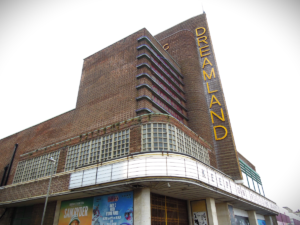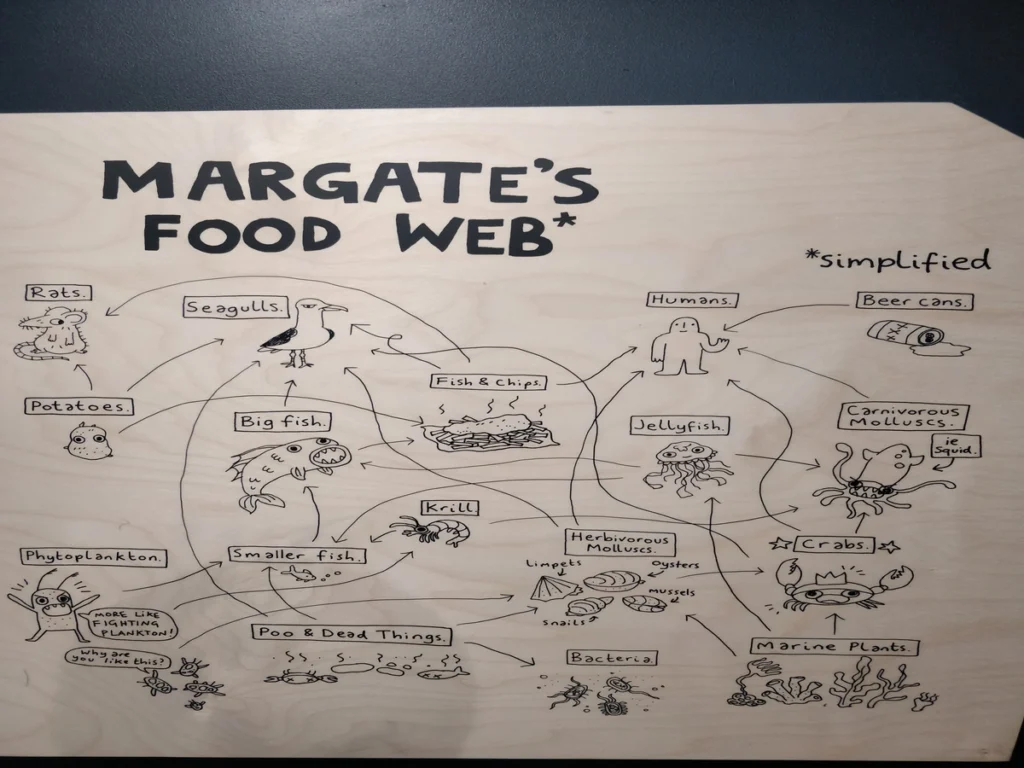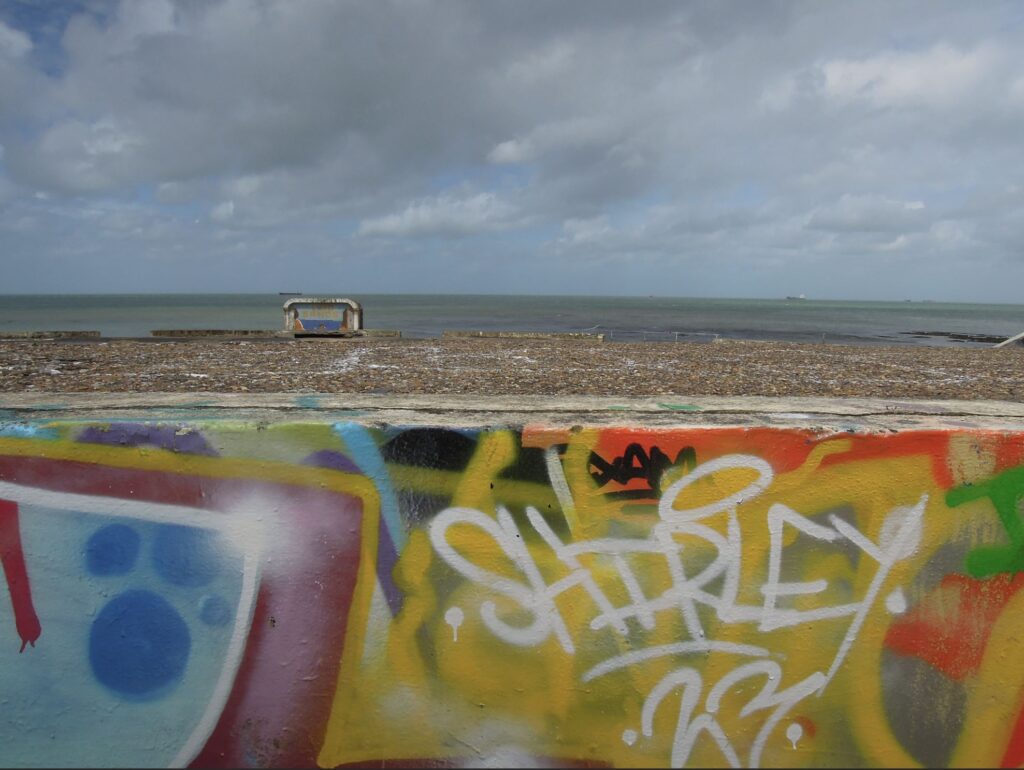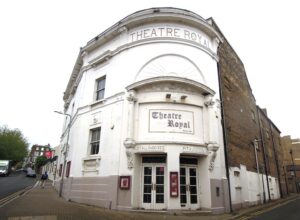| Distance : 6.3km (4miles) |
| Toilets : Station, or Turner Contemporary |
| Start : Margate railway station |
| End : Margate railway station |
| Hidden gem :Crab museum |

Overview

Turner Contemporary
I draw to Margate because it’s Turner Contemporary. Though the gallery doesn’t have any of Turner’s paintings on display, it is built on the site of the boarding house where Turner used to stay during his visits to Margate. He’s particularly fond of Margate’s skies and light and enjoyed the view from the guest house window. I’m glad to report I enjoy the view from the gallery too! As for the rest of the Margate, old town is bohemian, the beach is full of golden sand and the coastal path is easy to follow. If you want a lazy day out, Margate is the one.
Places of interests
Margate Railway Station

Façade

Ticket hall

The mural of T.S.Eliot anagram
The train station in Margate that we see now is neo-classical style built in the 1920s. It has simple and powerful lines with large bright windows. The ticket hall, waiting room and station cafe all kept the original design. In the café shop, you can see the original architecture charts. Another interesting spot is the tile mural just outside station’s toilet. Arnold Schwartzman, an artist who grew up in Margate, referenced the poet T.S.Eliot’s quote: “My name is just a combination of letters of the toilet.” T.S.Eliot’s most influential poem “The Waste Land” was partially drafted in Margate.
Here’s the proof from The Waste Land: “On Margate Sands.
I can connect
Nothing with nothing.
The broken fingernails of dirty hands.
My people humble people who expect
Nothing
“
Dreamland Cinema

The Art Deco cinema building
Completed in 1935, as an addition to the Dreamland Amusement Park, this art deco architecture was influenced by German cinemas in the 1920s. The tower design was proved to be influential on the design of Odeon cinemas. Though it looks derelict, it’s actually grade II listed and had £1.89m Coastal Communities Fund awarded back in 2014 to bring it back in use. The building work was completed in 2017, but the cinema remains closed. Let’s hope the private company that owns it doesn’t have a dodge plan on its usage of it.
Jubilee Clock Tower

The clock tower
The clock was built to commemorate Queen Victoria’s 70th Birthday. After two rounds of competition to find the design within the £800 budget, the work eventually commenced in August 1888 and the tower opened on 24 May 1889. There’s a time ball on the top, similar to the one in Greenwich Observatory. It is raised slowly just before 1pm each day and is dropped precisely on the hour. It was to allow ships off Margate and people in the town to set their clocks accurately before the time of radio.
Tudor House

The Tudor House
It’s the oldest building in Margate, built in 1525. It’s a unique example of a ‘transitional house’ – bridging the gap between medieval open-hall and early-modern houses with two storeys throughout. The house was occupied by Master Mariners, Flemish weavers, Cordwainers, and farmers. A malting was built at the rear to make Barley Beer in the 18th century and the building itself had been subdivided into 3 cottages by 1867. It was due for demolition before a local builder spotted the Tudor beams and alerted the Mayor after the Second World War. It was restored by 1951 and became grade II listed.
Turner Contemporary

Turner Contemporary
This is the reason I came to Margate, though a bit disappointed they don’t have any art from Turner. Well, it is contemporary. So, all the art here is very modern! I still liked it. The café there looks like a good place to rest with some Deli to fill your hungry stomach.
Other Art Galleries

Carl Freedman Gallery
Margate is still a mega for artists, it’s also Tracey Emin’s hometown. On Broad streets, there are 4 art galleries surrounding the crab museum. Each has its own style. Then there’s the Carl Freedman Gallery at 28 Union Cres. Tracey has her own studio: TKE Studios on Victoria Road, which is an art school.
Crab Museum

Doodle from the crab museum
This is definitely a hidden gem. I was attracted to it by its yellow doodle wall, and when I read it was free to enter, immediately I stepped in. The museum is on the first floor, not big but full of surprising knowledge you didn’t know about crabs. The highlight was the amazing talk the museum staff offered to children. I was drawn instantly by her enthusiasm and curiosity style.
Old Town

People eating at the square
The cheerful bit of the town. A handful of 16th and 17th-century buildings survived, providing a glimpse of the town before it became a seaside resort.
Lido

The swimming pool
Now a big car park, it used to be a vibrant part of Margate, an entertainment complex built by the Dreamland owner back in the 1920s. It was in use up till the 1980s. Artist Tracey Emin learned to swim there. Now only the Lido Beacon remains in its former glory, the rest of it is left to vandalising and erosion.
The Tom Thumb Theatre

Theatre building
The Tom Thumb Theatre is a family-run arts hub by the sea in the heart of Cliftonville, Margate. Originally built as a coachhouse in Victorian times, the building was transformed into one of the smallest theatres in the world in 1984. The Tom Thumb is a striking mix of Japanese and Alpine Architecture. It hosts spoken-word nights, comedy, story-telling, and burlesque. They also screen indie films.











Leave a Reply